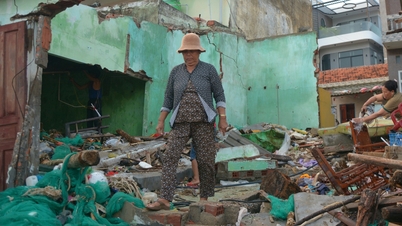
The elephant then went into a family’s kitchen in Tang village to look for food. This female elephant, living alone in the protected forest, was old and the only elephant left in the area.
Mr. Vi Van Kien in Tang village - who directly witnessed the behavior of the wild elephant said, when the family members were preparing to go to bed, they heard noises coming from the kitchen area. When they went down to check, they suddenly discovered a large wild elephant rummaging for food. However, it was only looking for salt, not eating other foods and vegetables and fruits in the kitchen. Immediately after that, he immediately ran up to the stilt house to find a flashlight, then shined it towards the elephant, used his phone to record the clip; at the same time, he shouted loudly for quite a while before the elephant left.
Mr. Vi Van Kien added that this elephant had appeared many times near his house, so his family felt uneasy, afraid that the elephant would destroy furniture, damage the house, or attack people.
Elderly people in Tang village said that in the past 5 years, people in the village witnessed wild elephants reappearing many times in the area. The one that appeared and entered the kitchen area of Mr. Vi Van Kien's house was a female elephant with a deformity in her hind foot.
Confirmed by the Pu Huong Nature Reserve Management Board, this elephant has left the forest environment many times to look for food near residential areas such as corn fields, sugarcane fields, and orchards of local people. Although it has not attacked humans, it has caused fear among local people. Most recently, in early August 2025, this wild elephant also appeared near a residential area in Manh village in Muong Chong commune, Nghe An province and local people also recorded the clip.
To limit the risk of conflict between elephants and humans, local forest rangers coordinate with local authorities and people to implement safe driving measures; at the same time, propagate and improve people's knowledge on how to identify traces, avoid contact with wild elephants and implement measures to protect crops.
Nghe An province is the locality where wild elephants are still recorded living in the wild. Currently, the local wild elephant population has about 14-16 individuals, distributed into 5 herds; of which, there are 3 single herds, with no ability to develop. In addition to 2 wild elephants (mother and child) in Quy Chau district (old), there is also 1 female elephant living in the forests of Bac Son commune (old Quy Hop district) and 1 female elephant in Chau Khe commune (old Con Cuong district). The herd of about 4 elephants in Pu Mat National Park, near the Vietnam - Laos border, has not been recorded in recent years, and is very likely to have "migrated" to Laos. The largest herd of elephants with 8 to 9 individuals is living in the buffer zone of Pu Mat National Park, often appearing in Cao Veu village, Phuc Son commune in the old Anh Son district.
In recent years, due to the shrinking forest area, habitat and scarce food sources, wild elephants have increasingly tended to move to areas near residential areas such as farms, fields... Most of the elephants in the herds living in the communes in Nghe An are mature, many are recorded to be old, and have difficulty reproducing. Therefore, to avoid the risk of decreasing numbers and facing the risk of elephant herds disappearing, the authorities and forestry sector need to have solutions to protect and support the development of wild elephant herds.
Source: https://baotintuc.vn/xa-hoi/voi-rung-xuat-hien-luc-tim-thuc-an-trong-bep-nha-dan-ban-tang-20251107150110679.htm


![[Photo] Da Nang: Hundreds of people join hands to clean up a vital tourist route after storm No. 13](https://vphoto.vietnam.vn/thumb/1200x675/vietnam/resource/IMAGE/2025/11/07/1762491638903_image-3-1353-jpg.webp)








































































































Comment (0)